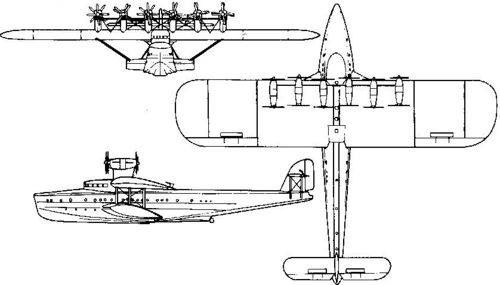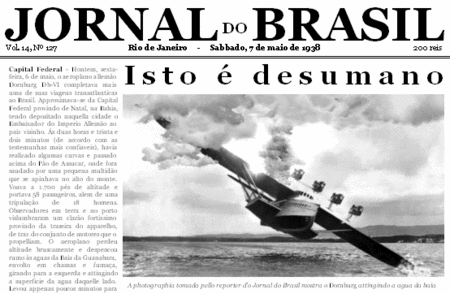Dornburg Disaster
It is commonly agreed that the single event that did most for the rejection of aeroplanes as a means of passenger transport - as opposed to airships - was the Dornburg Disaster of 1938.
The Db-VI and Its Career
The Dornburg Db-VI (colloquially known in German as Debe-Sechs) was an aeroplane of the “flying boat” type designed in 1935 and built in late 1936 by the German engineer Klaus von Dornburg. It was meant as an alternative to transportation by airship, intending to provide the same comfort with greater speed and comparable range. It had a duraluminium framework, largely enveloped in heavy fabric covered with waterproofing materials and aluminium paint.
Its technical specifications were:
- Crew: 18
- Capacity: 67 passengers
- Length: 140 p
- Wingspan: 160 p
- Height: 35 p
- Wing area: 5,200 p2
- Empty Weight: 86,500 lb
- Maximum Takeoff Weight: 172,000 lb
- Powerplant: 12 Dornburg Z23 air-cooled inline 12-cylinder engines at 280,000 W each
- Maximum Speed: 200 mi/h
- Cruise Speed: 140 mi/h
- Range: 1,150 mi
- Service Ceiling: 1,900 p
The plane had an alternative capacity of 100 passengers on short flights. The standard (“transatlantic”) outfit was similar to that of the best airships of the time, including a lounge, a dining salon with galley, passenger seating (convertible to berths at night), restrooms and showers on the main deck, and a control and navigation room with most of the technical equipment on the upper level. The lower deck contained diesel tanks and flotation compartments. Only one Db-VI was ever built; more advanced versions were planned for 1939 and subsequent years.
The first test flight took place on 3 January 1936; on 15 March there was a flight starting from the Bodensee (Lake of Constance) carrying 103 passengers and 22 journalists, with a reduced crew of 12. A slow ascent took the aeroplane to a height of only 600 feet; passengers were requested to assemble on one side or the other according to the turns the captain intended to make.
Commercial transatlantic flights, operated by Lufthansa, began on 2 April. The most common route went through Paris (France), Lisboa (Portugal), Saint James (Cape Green) and Biron (Venedic West Africa) to Natal (Bahia) and Rio de Janeiro (Brasil), sometimes refuelling at sea. Then it proceeded back to Natal, ultimately reaching New Amsterdam (NAL) via Belém (Equador), Kingston (Jamaica) and Kitty Hawk (NAL). The return trip passed through Santa Ester (NAL) and Ponta Delgada (Azores) before reaching Lisboa. There were eleven round trips in all.
The Disaster
On 6 May 1938 the Dornburg approached Rio de Janeiro after a normal voyage, having carried and deposited at Natal the Imperial German Ambassador to Bahia. While manoeuvering close to Guanabara Bay on its way to the mooring site, the aircraft performed two sharp turns because of unexpected winds. Witnesses on land and aboard ships in the harbour reported seeing a bright flash just aft of the bank of engines at 2:32 in the afternoon. Seconds later the plane – then at 1,700 feet, having cleared the top of Sugarloaf Mountain, a favourite sight of the passengers – lost height abruptly and fell into the bay enveloped in a mass of flames, striking the water with its left wing. The floating wreck was consumed in a matter of minutes; all attempts at rescue were futile and none of the 58 passengers and 18 crew members survived. This was the greatest loss of life in an aeroplane accident to date and ever since.
A reporter from Jornal do Brasil was a witness to the catastrophic landing process, taking photographs that became historic. The next day, JB headlines above the infamous pictures asserted Isto é desumano [This is inhuman]. The phrase stuck and became associated with the dangers of passenger travel by aeroplane.
Various theories were raised at the time to account for the disaster, including sabotage by a Venedan stowaway terrorist from Jakobina, and even gunfire from one of the forts surrounding the bay, where exercises with blank cannon shells had indeed been under way one hour earlier. We now know that the manoeuvers damaged the already weakened structure, which had apparently undergone inadequate maintenance at Cape Green, and the diesel lines to at least two engines burst and caught fire due to static electricity accumulated during an earlier thunderstorm over eastern Brasil. Modern research into the materials has discovered that the aluminium paint used in doping the plane's fuselage was equivalent to many of the rocket fuels currently in use in the space race, and that this could have been the true cause for the disaster.
Consequences
The Dornburg Disaster became prominent in public consciousness, and negative publicity against passenger aeroplanes has been an important factor ever since. The main reasons for rejecting large-scale civilian heavier-than-air transport may be summed up as follows:
- Aeroplanes are more unstable than airships, and weight shifting during flight can produce unrecoverable aerodynamic imbalance.
- Their relatively higher speed demands a very brief response time of the crew, leading to manoeuvers that are not always effective.
- Higher speed also means that static electricity buildup is more intense.
- Another consequence of higher velocities is the seriousness of damage in case of collision.
- Aircraft carry much more fuel than airships, to be used not only for propulsion, but also for lift – that is, not only to carry the aeroplane forward, but also to keep it in flight; this adds weight and risk of combustion.
- The framework of aeroplanes is subject to greater mechanical stress and therefore to a greater risk of mechanical failure.
Thus, the apparent convenience of shorter flight times is more than compensated – at least in the opinion of potential passengers – by the heightened risk of a fatal crash.
A memorial was erected at the site of the Dornburg Disaster, rising from the bottom of the bay to several feet above the high-tide level, bearing one of the original wing struts atop a concrete pedestal.



